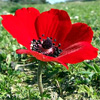A very common perennial with beautiful showy flowers in many colors. Anemones of all colors belong to the same botanical species and are inter fertile. The color of the flower is determined genetically by the respective parent plants. The common colors are red, white, pink, purple and blue. Altogether, there are 25 color types of anemones in Israel. Each flower blooms for a few weeks in mid winter. They open and close according to the sunshine and other weather conditions. In bright days the flowers track the sun's movement in the sky, capturing maximum radiation and warmth in the cold season.
Anemones have a rounded bulb close to the soil surface. The flowers and leaves emerge directly from this bulb. After the first rains the leaves break out. They have a long petiole and three dissected lobes. The flowers appear later in mid-winter, each carried on top of a leafless hairy stalk. The flower stalks are bent and break the ground with a special hook. Aboveground they straighten and bear a whorl of 3 bracts underneath the flower. As the flower ages, the distance to the bract increases, and in the red ones, a white ring develops at the base of the petals. The flowers have 5-6 colorful petals. The pistils and stamens in dark metallic blue, almost black, color are located at the center. The flowers attract beetles and bees that feed on the pollen released by the stamens while transferring pollen from one flower to another. The beetles probably take advantage of the large flowers also for meeting and copulating with the opposite sex. Each composite fruit contains hundreds of seeds that bear fluffy hairs which aid their dispersal by the wind.
Anemones are common in north and central regions of Israel, and even reach the edges of the desert in the south. The same species can be found in Greece Turkey and throughout the Middle East.





